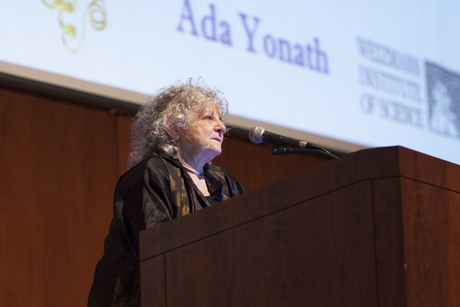
Nobelist Ada Yonath delivers the Efraim Racker Lecture in Biology and Medicine Nov. 14 on campus. Robert Barker/University Photography
One hundred may one day be the new 80, but it may be some time before living past 80 is a global standard for life expectancy, said Nobel laureate Ada Yonath, who delivered the 21st Efraim Racker Lecture in Biology and Medicine Nov. 14.
Yonath linked widespread use of antibiotics to increased human life expectancy. Her work on ribosomes has offered insight into helping researchers understand antibiotic resistance.
Yonath won the Nobel Prize for Chemistry in 2009 for her work determining the structure of ribosomes using cryo-crystallography, which freezes cellular components so they can be viewed with X-rays. Yonath and her research team developed the technique in conjunction with the Cornell High Energy Synchrotron Source (CHESS), a powerful synchrotron X-ray facility.
Ribosomes in cells decode messages sent from the nucleus and turn them into proteins, which are responsible for almost all cellular functions necessary for life; interfering with ribosome function can cause an organism to die. More than 40 percent of modern antibiotics are built to interfere with ribosomal functions in bacteria, Yonath said.
Antibiotics bind to important sites on the ribosomes of bacterial pathogens, preventing the translation of the genetic code into proteins. Without essential proteins, the pathogen dies. Increased life expectancy during the middle of the last century can be attributed to the increased clinical use of antibiotics, she said.
The trickiest part of using ribosomal antibiotics is ensuring that the antibiotic is disrupting the correct ribosome. “You don’t want to kill the patient, you want to kill the pathogen,” Yonath noted. While human and bacterial ribosomes are very similar in structure, there are subtle differences that allow antibiotics to bind to the correct structure.
Bacterial resistance has been a major obstacle for the use of antibiotics since about a decade after clinical antibiotic use began, Yonath said. “Pathogens are able to modify the anchors that antibiotics bind to. It is one of the most severe problems facing medicine today.”
There are, however, several ways to combat bacterial resistance. For example, drugs made of two compounds can reinforce each other and can bind with more anchors on ribosomes. These alternative interactions reduce the rate of bacterial resistance.
Yonath shared her hope that global life expectancy will one day reach over 80 years of age. “Pathogens don’t want to die,” she said. “And pharmaceutical companies need to take this problem more seriously.” If they don’t, Yonath said, within 30 years, bacterial resistance will spread, and illnesses will become as untreatable as they were before the clinical use of antibiotics.
The fourth woman in history, and the first woman from the Middle East, to win the Nobel Prize for Chemistry, Yonath, a professor of structural biology at Israel’s Weizmann Institute of Science, had an encouraging message for aspiring female scientists in the audience: “It is possible to be a good mother and a fantastic scientist. I still have time to teach my granddaughter’s kindergarten class about ribosomes.”
The Racker lectures, established in 1992, honor the late Cornell professor Efraim Racker, who discovered the mitochondrial enzyme responsible for synthesizing ATP and received the National Medal of Science in 1979.
In honor of what would have been her father’s 100th birthday this past June, Racker’s daughter Ann Costello presented the Efraim Racker website containing information about his life and work, including a gallery of his paintings.
